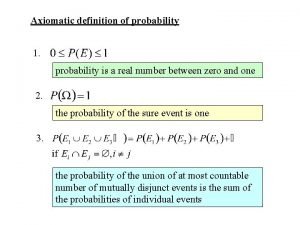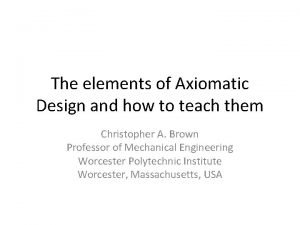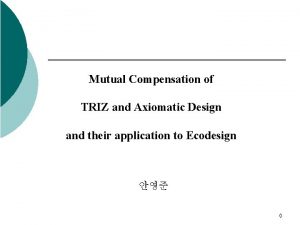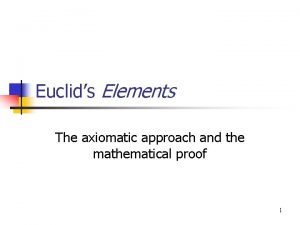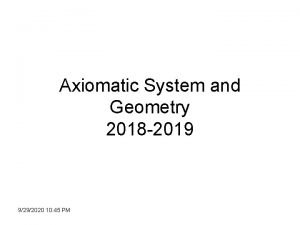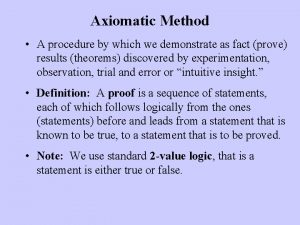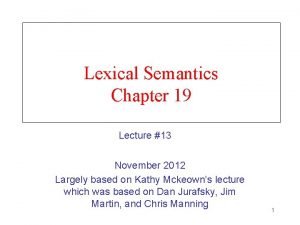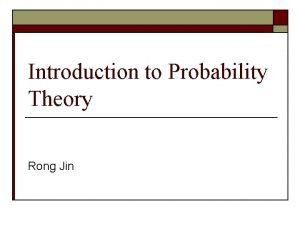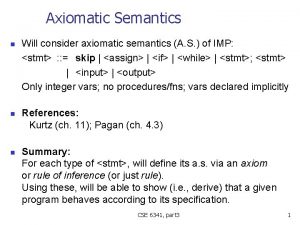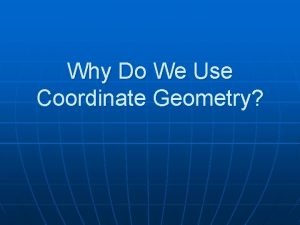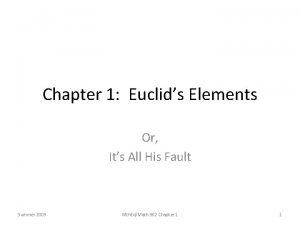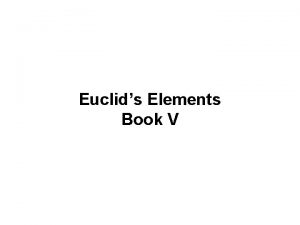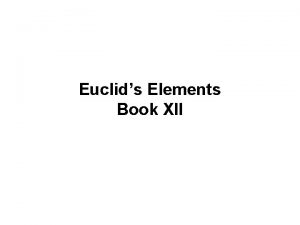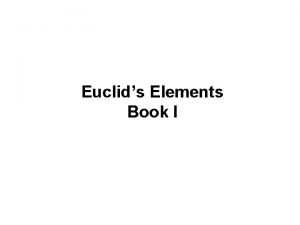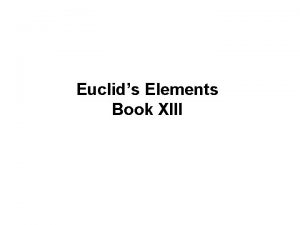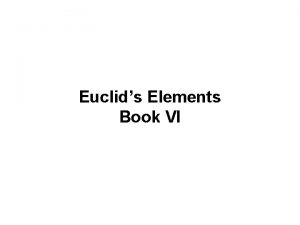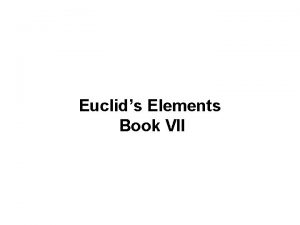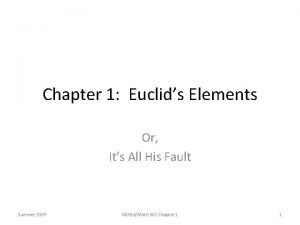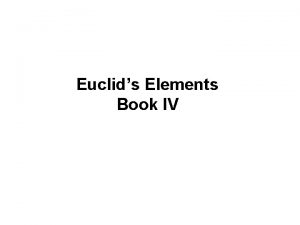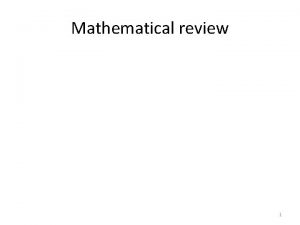Euclids Elements The axiomatic approach and the mathematical






















































- Slides: 54

Euclid’s Elements The axiomatic approach and the mathematical proof 1

Philosophy and Ancient Greece n n Ancient Greece was the cradle of philosophy based upon reason and logic. Its greatest triumph was the founding of mathematics. Euclid’s Elements 2

The great philosophers n n In the 4 th century B. C. E. , Plato (on the left) and Aristotle (on the right) represented the two most important philosophic positions. They each founded famous schools for philosophers: n n Euclid’s Elements Plato’s Academy Aristotle’s Lyceum Detail from Raphael’s School of Athens in the Vatican. 3

Logic at its Best n n n Where Plato and Aristotle agreed was over the role of reason and precise logical thinking. Plato: From abstraction to new abstraction. Aristotle: From empirical generalizations to unknown truths. Euclid’s Elements 4

Mathematical Reasoning n n n Plato’s Academy excelled in training mathematicians. Aristotle’s Lyceum excelled in working out logical systems. They came together in a great mathematical system. Euclid’s Elements 5

The Structure of Ancient Greek Civilization n Ancient Greek civilization is divided into two major periods, marked by the death of Alexander the Great. Euclid’s Elements 6

Hellenic Period n From about 800 to 323 BCE, the death of Alexander is the Hellenic Period. n n n Euclid’s Elements When the written Greek language evolved. When the major literary and philosophical works were written. When the Greek colonies grew strong and were eventually pulled together into an empire by Alexander the Great. 7

Hellenistic Period n n From the death of Alexander to the annexation of the Greek peninsula into the Roman Empire, and then on with diminishing influence until the fall of Rome. The most important scientific works from Ancient Greece came from the Hellenistic Age. Euclid’s Elements 8

Alexandria, in Egypt n n Alexander the Great conquered Egypt, where a city near the mouth of the Nile was founded in his honour. There was established a great center of learning and research in Alexandria: The Museum. Euclid’s Elements 9

Euclid n n Euclid headed up mathematical studies at the Museum. Little else is known about his life. He may have studied at Plato’s Academy. Euclid’s Elements 10

Euclid’s Elements n n n Euclid is now remembered for only one work, called The Elements. 13 “books” or volumes. Contains almost every known mathematical theorem, with logical proofs. Euclid’s Elements 11

Axioms n n n Euclid’s Elements start with stated assumptions and derive all results from them, systematically. The style of argument is Aristotelian logic. The subject matter is Platonic forms. Euclid’s Elements 12

Axioms, 2 n The axioms, or assumptions, are divided into three types: n n Definitions Postulates Common notions All are assumed true. Euclid’s Elements 13

Definitions n The definitions simply clarify what is meant by technical terms. E. g. , n n Euclid’s Elements 1. A point is that which has no part. 2. A line is breadthless length. 10. When a straight line set up on a straight line makes the adjacent angles equal to one another, each of the equal angles is right, and the straight line standing on the other is called a perpendicular to that on which it stands. … 15. A circle is a plane figure contained by one line such that all the straight lines falling upon it from one point among those lying within the figure are equal to one another. 14

Postulates n n There are 5 postulates. The first 3 are “construction” postulates, saying that he will assume that he can produce (Platonic) figures that meet his ideal definitions: n n n Euclid’s Elements 1. To draw a straight line from any point to any point. 2. To produce a finite straight line continuously in a straight line. 3. To describe a circle with any centre and distance. 15

Postulate 4 n n 4. That all right angles are equal to one another. Note that the equality of right angles was not rigorously implied by the definition. n n Euclid’s Elements 10. When a straight line set up on a straight line makes the adjacent angles equal to one another, each of the equal angles is right…. There could be other right angles not equal to these. The postulate rules that out. 16

The Controversial Postulate 5 n 5. That, if a straight line falling on two straight lines make the interior angles on the same side less than two right angles, the two straight lines, if produced indefinitely, meet on that side on which are the angles less than the two right angles. Euclid’s Elements 17

The Common Notions n Finally, Euclid adds 5 “common notions” for completeness. These are really essentially logical principles rather than specifically mathematical ideas: n n n Euclid’s Elements 1. Things which are equal to the same thing are also equal to one another. 2. If equals be added to equals, the wholes are equal. 3. If equals be subtracted from equals, the remainders are equal. 4. Things which coincide with one another are equal to one another. 5. The whole is greater than the part. 18

An Axiomatic System n n After all this preamble, Euclid is finally ready to prove some mathematical propositions. Nothing that follows makes further assumptions. Euclid’s Elements 19

Axiomatic Systems n n n The assumptions are clear and can be referred to. The deductive arguments are also clear and can be examined for logical flaws. The truth of any proposition then depends entirely on the assumptions and on the logical steps. n Euclid’s Elements Once some propositions are established, they can be used to establish others. 20

The Propositions in the Elements n n For illustration, we will follow the sequence of steps from the first proposition of book I that lead to the 47 th proposition of book I. This is more familiarly known as the Pythagorean Theorem. Euclid’s Elements 21

Proposition I. 1 On a given finite straight line to construct an equilateral triangle. n n Let AB be the given line. Draw a circle with centre A having radius AB. (Postulate 3) Draw another circle with centre B having radius AB. Call the point of intersection of the two circles C. Euclid’s Elements 22

Proposition I. 1, continued n n n Connect AC and BC (Postulate 1). AB and AC are radii of the same circle and therefore equal to each other (Definition 15, of a circle). Likewise AB=BC. Since AB=AC and AB=BC, AC=BC (Common Notion 1). Therefore triangle ABC is equilateral (Definition 20, of an equilateral triangle). Q. E. D. Euclid’s Elements 23

What Proposition I. 1 Accomplished n Proposition I. 1 showed that given only the assumptions that Euclid already made, he is able to show that he can construct an equilateral triangle on any given line. He can therefore use constructed equilateral triangles in other proofs without having to justify that they can be drawn all over again. Euclid’s Elements 24

Other propositions that are needed to prove I. 47 n Prop. I. 4 n Euclid’s Elements If two triangles have two sides of one triangle equal to two sides of the other triangle plus the angle between the sides that are equal in each triangle is the same, then the two triangles are congruent 25

Other propositions that are needed to prove I. 47 n Prop. I. 14 n n Euclid’s Elements Two adjacent right angles make a straight line. Definition 10 asserted the converse, that a perpendicular erected on a straight line makes two right angles. 26

Other propositions that are needed to prove I. 47 n Prop. I. 41 n Euclid’s Elements The area of a triangle is one half the area of a parallelogram with the same base and height. 27

Constructions that are required to prove I. 47 n Prop. I. 31 n Euclid’s Elements Given a line and a point not on the line, a line through the point can be constructed parallel to the first line. 28

Constructions that are required to prove I. 47 n Prop. I. 46 n Euclid’s Elements Given a straight line, a square can be constructed with the line as one side. 29

Proposition I. 47 n In right-angled triangles the square on the side subtending the right angle is equal to the squares on the sides containing the right angle. Euclid’s Elements 30

Proposition I. 47, 2 n n Draw a line parallel to the sides of the largest square, from the right angle vertex, A, to the far side of the triangle subtending it, L. Connect the points FC and AD, making ∆FBC and ΔABD. Euclid’s Elements 31

Proposition I. 47, 3 n The two shaded triangles are congruent (by Prop. I. 4) because the shorter sides are respectively sides of the constructed squares and the angle between them is an angle of the original right triangle, plus a right angle from a square. Euclid’s Elements 32

Proposition I. 47, 4 n The shaded triangle has the same base (BD) as the shaded rectangle, and the same height (DL), so it has exactly half the area of the rectangle, by Proposition I. 41. Euclid’s Elements 33

Proposition I. 47, 5 n Similarly, the other shaded triangle has half the area of the small square since it has the same base (FB) and height (GF). Euclid’s Elements 34

Proposition I. 47, 6 n Since the triangles had equal areas, twice their areas must also be equal to each other (Common notion 2), hence the shaded square and rectangle must also be equal to each other. Euclid’s Elements 35

Proposition I. 47, 7 n By the same reasoning, triangles constructed around the other non-right vertex of the original triangle can also be shown to be congruent. Euclid’s Elements 36

Proposition I. 47, 8 n And similarly, the other square and rectangle are also equal in area. Euclid’s Elements 37

Proposition I. 47, 9 n And finally, since the square across from the right angle consists of the two rectangles which have been shown equal to the squares on the sides of the right triangle, those squares together are equal in area to the square across from the right angle. Euclid’s Elements 38

Building Knowledge with an Axiomatic System n n n Generally agreed upon premises ("obviously" true) Tight logical implication Proofs by: n n n 1. Construction 2. Exhaustion 3. Reductio ad absurdum (reduction to absurdity) n n Euclid’s Elements -- assume a premise to be true -- deduce an absurd result 39

Example: Proposition IX. 20 n n There is no limit to the number of prime numbers Proved by n n n Euclid’s Elements 1. Constructing a new number. 2. Considering the consequences whether it is prime or not (method of exhaustion). 3. Showing that there is a contraction if there is not another prime number. (reduction ad absurdum). 40

Proof of Proposition IX. 20 n n Given a set of prime numbers, {P 1, P 2, P 3, . . . Pk} 1. Let Q = P 1 P 2 P 3. . . Pk + 1 (Multiply them all together and add 1) n n n 2. Q is either a new prime or a composite 3. If a new prime, the given set of primes is not complete. n n n Euclid’s Elements Example 1: {2, 3, 5} Q=2 x 3 x 5+1 =31 Q is prime, so the original set was not complete. 31 is not 2, 3, or 5 Example 2: {3, 5, 7} Q=3 x 5 x 7+1 =106 Q is composite. 41

Proof of Proposition IX. 20 n n n 4. If a composite, Q must be divisible by a prime number. -- Due to Proposition VII. 31, previously proven. -- Let that prime number be G. 5. G is either a new prime or one of the original set, {P 1, P 2, P 3, . . . Pk} 6. If G is one of the original set, it is divisible into P 1 P 2 P 3. . . Pk If so, G is also divisible into 1, (since G is divisible into Q) 7. This is an absurdity. n n n n Euclid’s Elements Q=106=2 x 53. Let G=2. G is a new prime (not 3, 5, or 7). If G was one of 3, 5, or 7, then it would be divisible into 3 x 5 x 7=105. But it is divisible into 106. Therefore it would be divisible into 1. This is absurd. 42

Proof of Proposition IX. 20 n n Follow the absurdity backwards. Trace back to assumption (line 6), that G was one of the original set. That must be false. The only remaining possibilities are that Q is a new prime, or G is a new prime. In any case, there is a prime other than the original set. n Euclid’s Elements Since the original set was of arbitrary size, there is always another prime, no matter how many are already accounted for. 43

The Axiomatic approach n n Euclid’s axiomatic presentation was so successful it became the model for the organization of all scientific theories – not just mathematics. In particular it was adopted by Isaac Newton in his Principia Mathematica, in 1687. Euclid’s Elements 44

The Axiomatic Structure of Newton's Principia n n Definitions, axioms, rules of reasoning, just like Euclid. Examples: n n Definition 1. The quantity of matter is the measure of the same, arising from its density and bulk conjunctly. n Euclid’s Elements How Newton is going to use the term “quantity of matter. ” 45

Rules of Reasoning n 1. We are to admit no more causes of natural things than such as are both true and sufficient to explain their appearances. n Euclid’s Elements This is the well-known Principle of Parsimony, also known as Ockham’s Razor. In short, it means that the best explanation is the simplest one that does the job. 46

The Axioms n n n 1. Every body continues in its state of rest of or uniform motion in right line unless it is compelled to change that state by forces impressed upon it. 2. The change in motion is proportional to the motive force impressed and is made in the direction of the right line in which that force is impressed. 3. To every action there is always opposed an equal reaction; or, the mutual actions of two bodies upon each other are always equal and directed to contrary parts. Euclid’s Elements 47

Known Empirical Laws Deduced n Just as Euclid showed that already known mathematical theorems follow logically from his axioms, Newton showed that the laws of motion discerned from observations by Galileo and Kepler followed from his axiomatic structure. Euclid’s Elements 48

Kepler’s Laws n n Newton’s very first proposition is Kepler’s 2 nd law (planets sweep out equal areas in equal times). It follows from Newton’s first two axioms (inertial motion and change of motion in direction of force) and Euclid’s formula for the area of a triangle. Euclid’s Elements 49

Kepler’s 2 nd Law illustrated n n In the diagram, a planet is moving inertially from point A along the line AB. S is the Sun. Consider the triangle ABS as “swept out” by the planet. When the planet gets to B, Newton supposes a sudden force is applied to the planet in the direction of the sun. This will cause the planet’s inertial motion to shift in the direction of point C. Euclid’s Elements 50

Kepler’s 2 nd Law illustrated, 2 n n Note that if instead of veering off to C, the planet continued in a straight line it would reach c (follow the dotted line) in the same time. Triangles ABS and Bc. S have equal area. n Equal base, same height. Euclid’s Elements 51

Kepler’s 2 nd Law illustrated, 3 n Newton showed that triangles BCS and Bc. S also have the same area. n n Think of BS as the common base. C and c are at the same height from BS extended. Therefore ABS and BCS are equal areas. n Things equal to the same thing are equal to each other. Euclid’s Elements 52

Kepler’s 2 nd Law illustrated, 4 n Now, imagine the sudden force toward the sun happening in more frequent intervals. n n The smaller triangles would also be equal in area. In the limiting case, the force acts continuously and any section taking an equal amount of time carves out an equal area. Euclid’s Elements 53

The Newtonian Model for true knowledge n n Axiomatic presentation. Mathematical precision and tight logic. n n With this Euclidean style, Newton showed that he could (in principle) account for all observed phenomena in the physical world, both in the heavens and on Earth. Implication: All science should have this format. n Euclid’s Elements This became the model for science. 54
 Plane geometry proofs
Plane geometry proofs What is a classical probability
What is a classical probability Mathematical economics vs non mathematical economics
Mathematical economics vs non mathematical economics Axiomatic design example
Axiomatic design example Systematic oo
Systematic oo Axiomatic system definition
Axiomatic system definition Axiomatic design
Axiomatic design The axiomatic method
The axiomatic method Axiomatic system of geometry
Axiomatic system of geometry Definition in an axiomatic system
Definition in an axiomatic system Axiomatic antonym
Axiomatic antonym Axiomatic definition of probability
Axiomatic definition of probability Difference between datagram and virtual circuit switching
Difference between datagram and virtual circuit switching Tony wagner's seven survival skills
Tony wagner's seven survival skills Cognitive approach vs behavioral approach
Cognitive approach vs behavioral approach Waterfall approach vs shower approach
Waterfall approach vs shower approach Multi approach avoidance conflict
Multi approach avoidance conflict Cognitive approach vs behavioral approach
Cognitive approach vs behavioral approach What is research approach
What is research approach Traditional approach of development
Traditional approach of development Oracle landed cost management
Oracle landed cost management Common elements approach
Common elements approach Hình ảnh bộ gõ cơ thể búng tay
Hình ảnh bộ gõ cơ thể búng tay Lp html
Lp html Bổ thể
Bổ thể Tỉ lệ cơ thể trẻ em
Tỉ lệ cơ thể trẻ em Gấu đi như thế nào
Gấu đi như thế nào Tư thế worm breton là gì
Tư thế worm breton là gì Hát lên người ơi alleluia
Hát lên người ơi alleluia Các môn thể thao bắt đầu bằng tiếng bóng
Các môn thể thao bắt đầu bằng tiếng bóng Thế nào là hệ số cao nhất
Thế nào là hệ số cao nhất Các châu lục và đại dương trên thế giới
Các châu lục và đại dương trên thế giới Công của trọng lực
Công của trọng lực Trời xanh đây là của chúng ta thể thơ
Trời xanh đây là của chúng ta thể thơ Cách giải mật thư tọa độ
Cách giải mật thư tọa độ Làm thế nào để 102-1=99
Làm thế nào để 102-1=99 Phản ứng thế ankan
Phản ứng thế ankan Các châu lục và đại dương trên thế giới
Các châu lục và đại dương trên thế giới Thơ thất ngôn tứ tuyệt đường luật
Thơ thất ngôn tứ tuyệt đường luật Quá trình desamine hóa có thể tạo ra
Quá trình desamine hóa có thể tạo ra Một số thể thơ truyền thống
Một số thể thơ truyền thống Cái miệng nó xinh thế
Cái miệng nó xinh thế Vẽ hình chiếu vuông góc của vật thể sau
Vẽ hình chiếu vuông góc của vật thể sau Nguyên nhân của sự mỏi cơ sinh 8
Nguyên nhân của sự mỏi cơ sinh 8 đặc điểm cơ thể của người tối cổ
đặc điểm cơ thể của người tối cổ Ví dụ về giọng cùng tên
Ví dụ về giọng cùng tên Vẽ hình chiếu đứng bằng cạnh của vật thể
Vẽ hình chiếu đứng bằng cạnh của vật thể Fecboak
Fecboak Thẻ vin
Thẻ vin đại từ thay thế
đại từ thay thế điện thế nghỉ
điện thế nghỉ Tư thế ngồi viết
Tư thế ngồi viết Diễn thế sinh thái là
Diễn thế sinh thái là Các loại đột biến cấu trúc nhiễm sắc thể
Các loại đột biến cấu trúc nhiễm sắc thể Các số nguyên tố là gì
Các số nguyên tố là gì

